明日科企新星 勇闖矽谷集資 打開心扉 增賣蹺成功率
20 Nov 2014
近年與科技有關的初創企業(Startup)搶盡風頭,連首富李嘉誠也被吸引,不介意與80、90後一起「玩」。
早前有初創企業在Google與中大創業研究中心合辦的「EYE年輕創業家計劃」突圍,到矽谷了解當地創業文化,嘗試籌集資金。能否籌到資金言之尚早,贏了寶貴經驗最難得。
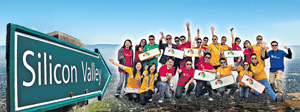
多間香港初創企業,早前在Google帶領下,到矽谷交流。(梁巧恩攝)
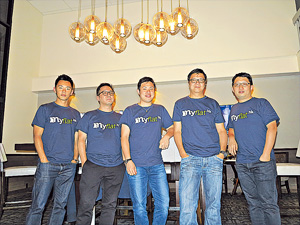
Myflat團隊人多,有齊投資界及科技界人才。(梁巧恩攝)
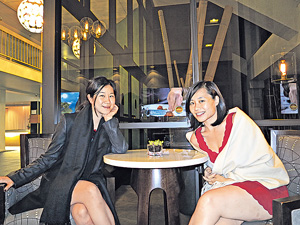
職到其中兩個創辦人也有生意經驗,10月推出測試版。(梁巧恩攝)
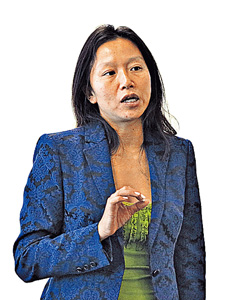
500.co投資了多間初創企業,其Managing Partner Bedy表示,做推介時要較開放,多談賺錢方式,較吸引美國投資者。(梁巧恩攝)
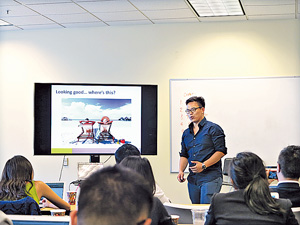
Tra.fluence向投資者推新想法,希望得到專業意見。(梁巧恩攝)
【個案1】鄰舍網絡化 打造共享經濟
社交網絡選擇多,網上交朋友時,卻難以核實對方身份,很難暢所欲言。
myflat.hk看中這個「信心危機」以及鄰舍之間守望相助的需求,由香港開始,建立一個「信得過」的鄰舍社交網絡。創辦人之一的黃景龍解釋:「會寄出內附密碼的信給會員,以密碼登入核實身份。」
準確投放廣告 吸商戶
網絡已推出測試版約半年,現階段分區域及屋苑兩個層次,區域人人可加入,但屋苑網絡必須經過核實身份。「約有3,000個用戶,大部分在區域網絡活動。」一旦鄰舍網絡形成,會員間不但可發揮互助精神,創辦人更希望發揮共享經濟的好處,大家毋須過度消費,也可解決生活所需。
網絡的收入來源,則靠廣告費。經核實的資料,在廣告商眼中相當有用,可以更準確地投放廣告。「有街市的商戶希望登廣告,向目標顧客宣傳。」
其Founding Partner鄭思行相信,現階段要盡量吸客,只要能吸引到13%的港人使用,網站的競爭力就會更高。「賺錢未是首要目標,可能每個客戶收5元月費,會賺到一點錢,但上客量就會慢幾倍了。」
黃景龍坦言,希望先做好香港市場,站穩後再向亞洲其他城市如新加坡等地進發,未考慮發展內地市場。希望找到對科企有遠見的投資者支持發展。
專家教路:
‧說清楚如何建立誠信,為何網民要相信網站。
‧做演示時,影像要與內容配合,否則會誤導觀眾。
‧別說太多鄰舍關係,點出問題後,宜立刻道出生意模式。
【個案2】網上平台 極速撮合僱主僱員
企業想要人才,尤其是飲食業、酒店業經常需要大量臨時工。身體健康的退休人士以及想重投職場的婦女,希望做兼職又苦無機會,這種社會資源錯配,幾乎在全球主要城市有出現。
職到(Jobdoh)的3位創辦人看到這問題,希望建立一個網上平台及應用程式,速配僱主及僱員。創辦人之一的黃貝芝指:「現時香港有逾50%的長者擁智能電話,他們也懂得上網,不難接觸。」職到又會到社區中心、非牟利組織做宣傳,尋找合作機會,相信不難接觸潛在僱員。
助長者婦女覓兼職
至於僱主,則先由酒店業開始,皆因黃貝芝本身有經營紅酒生意,在酒店業行內有一定人脈關係。「暫時已聯絡了10多個僱主,並已開始做工作配對。」
她坦言,現階段最重要是理解僱主及僱員的需要,並測試不同版面組合,看哪些的方便度較高,較為僱主及僱員接受。另一創辦人張譯之指:「用戶經驗相當重要,必須做好測試。」雖然這種中介人工作並不新鮮,但她們相信,透過手機應用程式,僱主及僱員雙方可更快配對,效率是突圍優勢。
職到希望,6個月內可吸引到500個僱主,投放5,000個職位空缺資料。12個月內可把市場發展至澳門及深圳。「我們在這些地方有一定的人脈。」至於賺錢方式很簡單,就是向僱主收取職位工資的10%至20%作介紹費,並希望集資繼續發展。
專家教路:
‧若有實際僱主如某某酒店,可作為個案介紹整個運作,更清楚運作過程。
‧美國有些網站,可速配臨時工作,包括如用20美元請人打掃家居兩小時,值得參考。
【個案3】網上尋旅伴 推介旅遊產品
熱愛旅行人士,經常也遇到一個問題,就是找不到旅伴,又要花時間去找酒店、交通。旅行發燒友Cynthia及Edward想到,可透過社交網絡,找尋旅伴,並為旅遊產品與旅者做配對,成立Tra.fluence。
擬明年推試用版
Cynthia表示,預計明年會推出服務測試版,會先由團隊的Facebook朋友圈出發,再發揮「傳染」效應。「利用其應用程式界面(Application Programming Interface,API)做推廣。」希望fb上熱愛去旅行的網友先說出自己的「旅行希望」,有合適的產品才轉發給他們,他們可根據個人喜好、經驗給予評價,再分享給其他朋友。
Cynthia強調,現階段正努力做好版面設計,以及了解用戶的看法,並開始與各旅遊產品供應商聯絡。「最終希望在不同社交網絡上運作,甚至有足夠的用戶,到自己的網站。」
由於仍在初步發展階段,另一創辦人Edward指,很難預計上客量及賺錢時間表。「現時想引入更多專家提供意見,籌集資金反而是其次。」
專家教路:
‧平台推出後,如何肯定目標顧客能找到你?。
‧要令目標顧客找到你,要花多少宣傳費?
‧現時酒店、航空公司給予中介公司的的佣金不高。
撰文: 梁巧恩
A breath of fresh flair: young Hong Kong entrepreneurs chase start-up dreams in Silicon Valley
15 Nov 2014
On a whistle-stop tour of Silicon Valley, some of Hong Kong’s most promising young entrepreneurs learn the risks and rewards of chasing their start-up dream. Words and pictures by Jo Baker.
BY JO BAKER 15 NOV 2014
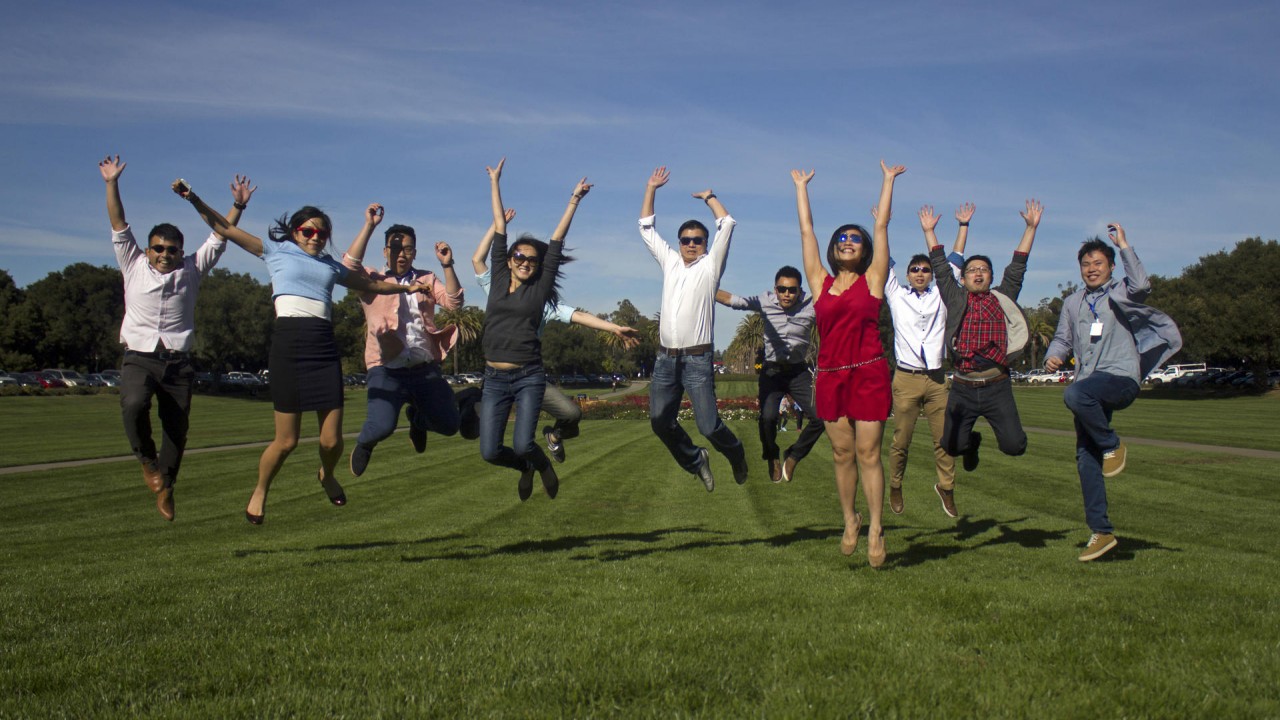 Participants in the Empowering Young Entrepreneurs programme at Google’s Silicon Valley campus
Participants in the Empowering Young Entrepreneurs programme at Google’s Silicon Valley campus
Jeremy Lai Chun-kei’s eyes gleam through his jet lag as Google campus bicycles sail by in familiar green-red-yellow colours and a Bay Area breeze chills the air.
“In America, particularly Silicon Valley, there’s a willingness to invest in dreams,” says the young entrepreneur. “But in Hong Kong, you see that ‘make it happen’ attitude much more rarely, particularly when it comes to start-ups.”
That’s something he and those with him intend to change, with a little help from a certain search engine.
Ten months earlier, Lai and his future business partners, then yet to meet, had been among a 600-strong crowd of young tech-minded aspirants, gathering for what each hoped would be the chance of their careers. The Empowering Young Entrepreneurs (EYE) programme was announced by Google’s executive chairman, Eric Schmidt, in partnership with the Chinese University of Hong Kong’s Centre for Entrepreneurship. It aimed to attract bold new blood to the city’s emerging tech-driven start-up scene, and help to fill a gap that both organisations believe exists to Hong Kong’s detriment.
“Investing in tech-driven start-ups is an important way for Hong Kong to build on its global reputation and stay competitive,” says Dominic Allon, managing director of Google Hong Kong. “But it’s still not easy to be a young entrepreneur here. We need to connect the raw talent here with better infrastructure and support.”
The programme joined a modest series of funding and training initiatives already serving tech entrepreneurs in the city - but brought with it a little Google pizzazz. A skills-training boot camp for 900 at Chinese University would be followed by a selective mentoring programme for 40 promising teams, largely at weekends over the course of the year, in which they would refine their business plans and build their prototypes. Then, after a series of competitions, the six teams with the best ideas would be flown to America’s pioneering tech hub in northern California, known as Silicon Valley, for a packed tour of major tech organisations and start-ups. There they would get to meet, learn from and pitch to a series of big names in innovation, get a sense of what success could look like in a mature market for venture capital investments - and think about how to help Hong Kong get there.
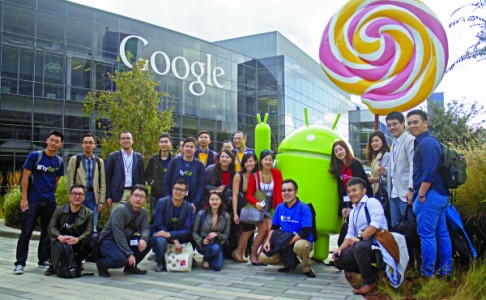
Participants in the EYE programme at Google’s Silicon Valley campus
GOOGLE HEADQUARTERS, MOUNTAIN VIEW, California. Notebooks and coffee cups lay discarded across a large meeting room as 13 Hong Kong twenty-somethings, dutifully clad in Google-coloured tees, sit absorbed in a series of slides. There’s Google’s self-driving car, a smart contact lens that helps to manage diabetes and Project Loon - a balloon network on the edge of space that connects people in remote areas to the internet.
“We call it moonshot technology,” says Amanda Kelly, product development manager at Google X, a semi-secret facility dedicated to making major technological advancements, as she flicks through the inventions. “It’s about taking a huge problem and looking for a solution that’s not incrementally better than other solutions but at least 10 times better. It’s about radical, disruptive thinking.”
Two of the groups are listening particularly intently. Lai’s three-man team, Optica - formed when he was asked to join a talented duo from mainland China during EYE - believe their technology will help colour-blind people overcome visual disadvantages, largely via a Google Glass-style headset. Talk-now is an award-winning wearable device, under development, that will translate sign language gestures into speech.
“This kind of thinking can inspire us to aim even higher,” says Talk-now’s project manager, Chinese University graduate Kenneth Chung Man-hon. “For example, we have thought so far about how to allow mute people to be understood by others, but sign language vocabulary is actually quite limited, at just about 100 words. What if we can take this further so that by connecting mute people across the world, new vocabulary can be created?”
And over the next five days, during the group’s string of meetings with start-up founders and chief executives, a Silicon Valley ethos - largely centred on pushing boundaries, breaking moulds and embracing failure - begins to takes shape, and sink in.
“AS A COMPANY IT’S NOT about your successes, but what you’ve learned from your failures,” announces Jeffrey Smith on day three. The software engineer, who co-founded the start-up Smule - which he calls an online “global fireplace” for music-making - off the back of a PhD in music, regales the group in a predictably quirky loft-style office in San Francisco’s SoMa district, complete with exposed-brick walls, a fully stocked kitchen and a grand piano. And his words carry weight. “I have spent my life running companies that I have started,” he says. “You need to be transparent to be successful. Hire creative people and then create a culture in which failures can be appreciated and problems shared.”
At Stanford University, the key themes are passion and resilience.
“I get thousands of letters from young people in Asia saying, thank you ‘for telling me that I can break the rules’ and reminding them that a lot of rules in their society are really just recommendations,” says Tina Seelig, executive director of Stanford’s Technology Ventures programme and author of books on innovation, entrepreneurship and risk. “It takes a tremendous amount of work to innovate and push beyond the obvious answer, and starting a company is hard. You should be able to do it even when people say you’re crazy.”
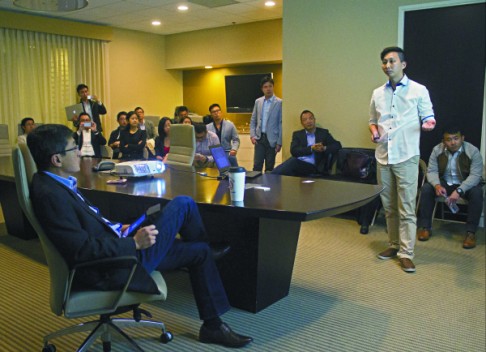
Kenneth Chung practises pitching
The messages hit home. Interim results from a study by the Centre for Entrepreneurship and Google Hong Kong, released earlier this year, reveal that Hong Kong’s financial success has left it with little appetite for risk, and a low entrepreneurial spirit, largely due to the social pressure applied on those who consider the start-up path. Among the entrepreneurs it surveyed, pressure from family and friends had increased 39 per cent and 436 per cent, respectively, after their enrolment into start-up-related programmes.
“I have friends who are very talented in areas such as coding, but who chose careers in something else, like finance, mostly because their parents didn’t think the reputation of coding was good enough,” says EYE participant Matthew Tam Chun-kit, whose start-up, Myflat.hk creates online networks among neighbours. “I probably got away with it because I had already worked in finance and so my parents think that at least I can go back to that if I need to - but it wasn’t easy to convince them.”
Also on the trip, Xania Wong says she chose to leave a successful family wine business to co-create Jobdoh, a mobile booking platform that connects casual workers and employers. Even her entrepreneurial parents were unhappy with her decision. “And my friends think I’m crazy,” she adds, wryly.
Smith’s reflections on failure, in particular, resonate. Many of the young entrepreneurs consider the notion of success in Hong Kong to be prohibitively narrow and the pressure to make money quickly extremely high. Yet, says Allon, some of Silicon Valley’s most sought-after chief executives have failed on various occasions and are valued for that very reason.
“Failure makes you better here - it carries kudos,” he says. “I hope they’re learning that there are ways that you can fail well, and that it’s therefore not something to be afraid of.”
Indeed, for many on the trip, the change of location means a new identity of sorts: from black sheep to something … cooler.
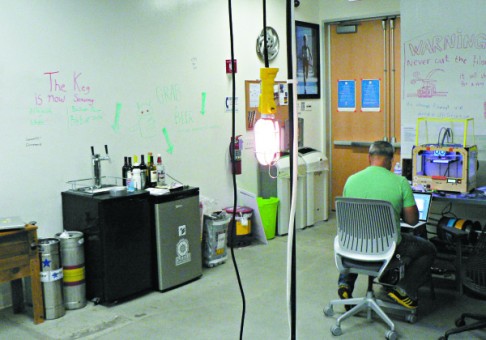
The Google Garage, a 24-hour lap open to all employees
“Here, anyone doing a start-up is basically a rock star,” successful start-up founder Martin Frid-Nielsen tells the group during a panel discussion. “Sure, you may be a starving one, and your music may need some work, but you’re cool - and you get to be with people just like you.”
“There’s such an ingrained atmosphere for entrepreneurship,” says Lai, at the end of day four. “It feels like everyone is willing each other to succeed. For me, it’s perhaps most incredible to see how many founders and CEOs of successful companies are willing to genuinely share their experiences and help each other out.”
But social pressure is not the only problem facing entrepreneurs in Hong Kong. Eighty-eight per cent of the 612 entrepreneurs surveyed by the Chinese University were mainly self-funded and for 50 per cent, that was the only funding they had. Despite the abundance of Hong Kong’s financial resources, early stage investment and seed capital for local start-ups is elusive, and with the exception of a few high-profile pioneers, investors are mostly still reluctant to fund domestic projects.
“This is still a completely new ecosystem for investors, and they are still very biased towards finance,” says Antony Wong King-lung, from the Myflat.hk team. “But Li Ka-shing has shown that we need to diversify and I think other investors should do that, too, because we’re moving to a different kind of economy.”
INDEED, THE ENTIRE TRIP - while providing technical tips and pointers on business plans and pitching - gives rise to reflection on the kind of culture Hong Kong will need in order to thrive in the tech age, and the importance of it doing so. Many hopefully refer to the city as a potential regional headquarters for start-ups, citing its success as a global financial hub, its business-friendly policies and good infrastructure - and the value of such a reinvigoration as it reappraises its role in relation to the mainland.
“We need to get away from this idea that success is still just pure money and move with the global shift towards technology and new ideas,” says Theodore Ma Heng, Hong Kong entrepreneur and founder of co-working space CoCoon, which supported EYE. “We need a culture that embraces risk and agility, and people who don’t conform to traditional ways of doing business. Traditional markets are important, but where are we evolving? What’s next?”
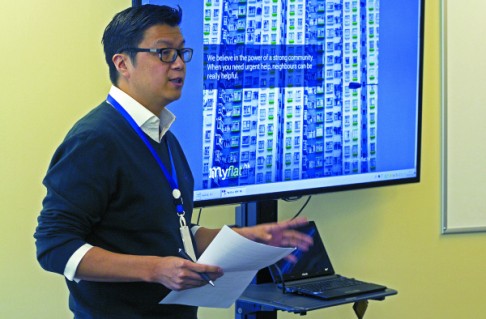
Matthew Tam, of myflat.hk
There are, however, signs that a supportive ecosystem is starting to be nurtured in the city. Most of the winning EYE teams have benefited from some other form of help, such as incubator programmes at the Hong Kong Science Park and Cyberport, the PolyU Micro Fund 2014 and Invest HK’s Startmeup programme. The Chinese University study reported a 300 per cent growth in the territory’s physical infrastructure and services since 2008, including accelerators such as start-up incubator NEST and co-working spaces like CoCoon, which organises competitions, internships and pitch nights with judges from the business community.
“Hong Kong is waking up,” says Kevin Au Yuk-fai, director of the Chinese University’s Centre for Entrepreneurship, on the release of the interim results in September. “And it is doing it with its well-known dynamism and drive. Initiatives like the EYE programme are making a sizeable contribution to advancing Hong Kong’s overall start-up community, and we now encourage more participation from the broader society to make an even bigger impact.”
Of course, it’s hardly fair to compare Hong Kong with the American tech hub, acknowledges EYE participant Eddie Lin Chin-ngai. “Silicon Valley is a unique product of its environment, and of the American culture,” says the entrepreneur, whose start-up, HITA, aims to be the go-to platform for indie music in the region. As a regional hub and one so close to the mainland, he says, it will naturally have different needs and strengths.
MOST AGREE ON THE INGREDIENTS that Hong Kong’s start-up scene will need to thrive. Better hard infrastructure - accelerators, workspace and seed capital - is key, while education could better connect the dots between business and innovation, says Mingles Tsoi Ming-to, who managed much of the EYE programme as project director at the Centre for Entrepreneurship. He acknowledges that the overseas education of almost all of the EYE winners probably gave them an advantage. Initiatives to boost the low numbers of women starting their own businesses, particularly in technology, are also sorely needed. Only three of the winning 14 EYE participants were women, and various reports, including one commissioned this year by The Women’s Foundation in Hong Kong, highlight the stark gender gap in the city’s technology and high-growth start-up scene. The foundation holds stereotyping and male-predominant networks largely to blame, recommending training and mentoring for female business owners and better access to R&D and technology.
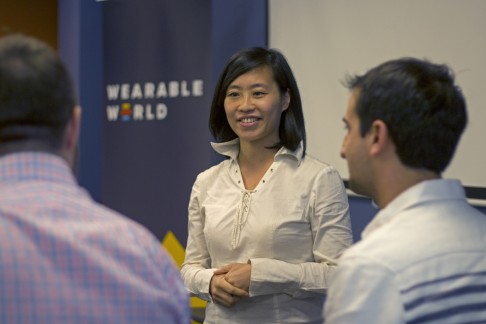
Xania Wong, of jobdoh
And youth, too, remains a barrier.
“In Hong Kong there’s a perception that going fresh from university to entrepreneurship is silly,” says EYE participant Edward Leung Zheng, who co-founded Trafluence, an online marketplace for travellers. “But the people we’ve seen in the past few days have had great concepts, enthusiasm and the right connections, and they’ve come straight out of college. I just think that, with the right community, ecosystem and mentors around you, age doesn’t matter that much.”
The group hope that greater support from their communities, and investors, will come. Leung’s partner at Trafluence, Cynthia Cheung Sze-wai, remarked that as the first among her Hong Kong friends to try the start-up path, she feels many will be watching her closely as they consider their own options.
After all, says Lai, Hong Kong was built on the vision and drive of entrepreneurs.
“Hong Kong was a fishing village just over 100 years ago, and let’s not forget the Li Ka-shings, the Lees, the Chengs,” he says. “They didn’t have much but because they were at the right place and time with the right mindset, they prospered. I don’t see why that mindset can’t be extended for the future.
“Hong Kong just needs more role models, to show it can be done, and to help others have more confidence and take that gamble. That’s what we’re all trying to be.”
##EYE programme: the winners##
HITA (hita.me) Aim: to connect and showcase independent musicians and music lovers online, in the region and globally, via an integrated music tool. Seeking funding? No. Jobdoh (jobdoh.com) Aim: to provide a mobile platform for last-minute booking of casual work for employees and employers. The goal is to become a go-to platform, with particular focus on the food and beverage, exhibition, market research and logistics industries. Seeking funding? No. Myflat.hk Aim: to connect real neighbours online, strengthen community spirit and connect local businesses with target customers via a private neighbourhood social network. Seeking funding? Yes. Optica Aim: to help the colour blind overcome their visual disadvantage, largely through a Google Glass-style headset, with a focus on the film post-production industry and medical technology companies. Seeking funding? Yes. Talk-now Aim: to overcome communication obstacles between those with hearing and/or speaking impairments, using a wearable device that translates sign language into voice. Seeking funding? Yes. Trafluence (trafluence.com) Aim: to connect tourismdependent service providers with talented and influential travellers around the world via an online marketplace. Seeking funding? No.
##BREATH OF FRESH FLAIR - VISION STATEMENT##
Frederik Pferdt (below), head of innovation and creativity programmes at Google, says the company has a unique approach to fostering innovation in the workplace.
“Innovation can’t really be instructed, but you can allow it to happen if you create the environment for it. We have principles that allow this culture to operate. One is our mission statement [‘Organise the world’s information and make it universally accessible and useful’]: it’s important to have that statement for making the world a better place. Sure the free food and massages are perks, but it’s all about having a mission that motivates Googlers to come here every day and know that they can impact a lot of people’s lives.
“The second is transparency. You’ll notice that you can see into a lot of offices and workspaces, and the offices are often very open-designed. We try to engineer serendipity into our workspace design, where on a lot of occasions throughout the day, people can meet from other departments, share ideas and learn from each other. Everyone has access to everyone’s calendars. If I see that people are meeting on a specific topic that I can add value to, it’s absolutely fine to join it. Our transparency works vertically, too. Leaders share all the information they have, and everything is available to find out. You can’t take credit as a manager for your people’s work, or take credit for something you didn’t work on. And you may have heard of our TGIF, Thank Google it’s Friday meeting? Now this is on Thursday evening so that everyone can participate, as it’s streamed across the world. [Google founders] Larry [Page] and Sergey [Brin] are here every Thursday for an hour and a half to present updates on the company and take live questions. That level of transparency is unbelievable and creates an environment of trust between peers, co-workers and leaders.
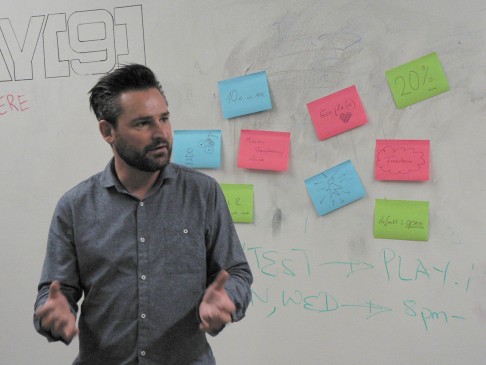
“Freedom is a lot of what our culture is about. If you give people freedom, they will amaze you. Ideas and innovation can happen anywhere, from the intern that works here from four to six months to the VP of a product area. At Google, we have something called 20 Per Cent Time. Every employee has about one day per week to work on things that might be their hobbies, not related to their core project. A software engineer or someone in marketing would probably do something similar on the weekends anyway, so if you help them to bring it into the organisation, give them an environment to experiment - like our shared 24-hour lab space, the Garage - we benefit and share. We have a track record of some of those 20 Per Cent projects being turned into real products. Take Gmail, which was created by one engineer in his 20 per cent Time. It wasn’t part of Google’s strategy at the time but it’s now one of our most successful products. Here you’ll find people working on anything you can imagine, from 3D printing to code.
“We encourage people not just to encourage solutions that are incremental - like something a little bit faster - but solutions that are 10 times better. And those solutions you can see in various products, like our self-driving cars, which are a whole new level of reimagining the car. Look at Google Fiber - that created 100-times faster internet. This is the language we use in the organisation about what ideas we should follow. In five years, if we improve our products by just 10 per cent, eventually there will be a competitor who will overtake us in the market.
“Lastly, you need to create a soft bed so people can fail well. A lot of people are taking high risks here, but people know they can because we create an environment in which they can actually fail. Failing well means that even if the product is not successful or goes in the wrong direction and we have to pull the plug, those people are the most demanded teams in Google, because now they have valuable information for making another project work.”